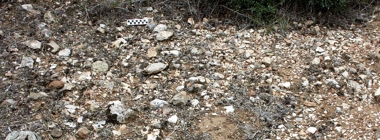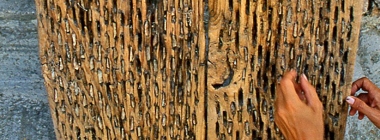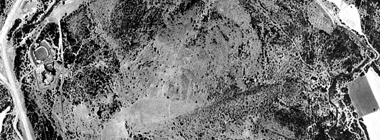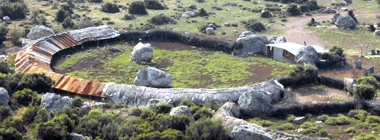The Lithic Scatter and its Formation
The scatter on the slopes of the hill contains millions of silex fragments, but only a small fraction of these are diagnosable as products of reduction sequences geared to tool manufacture (Fig. 5). The highest ratio of such reduction products we have recorded in samples with more than 100 silex fragments is 8.1% (9.4% by weight), but the mean of 64 such samples is only 1.3% and the median half that figure. The remainder is angular fragments, some of which are natural clastics (derived from the weathering of the rock), some are debris from prehistoric quarrying, and some (most?) are byproducts of activities at the site during the historical period.
In mid-20th century, for instance, the hill served for some time as a mortar testing range for the Greek army. (This did not seriously damage Vrahos itself, but may be responsible for the excessive amounts of fresh gravel seen in some areas.) In the 1940s a man who lived in a nearby village, a refugee from Cappadocia, used to carry Vrahos silex to his home and work it into armature for threshing sledges. (We visited the village and found one of his works: Fig. 6) Goats have been herded on the hill for centuries or longer, as is shown by the ruins of several animal pens (beside two animal pens in operation today; Fig. 7). At an older time yet, the upper reaches of the hill were terraced, and a large building complex stood near the foot of Vrahos on its south side. The foundations, still preserved, are constructed entirely of boulders and cobbles of Vrahos silex. A few large silex boulders were at one point moved some distance to form a quasi-megalithic structure north of Vrahos, and people may have been buried on the south slope.
These and other uses of the hill in the course of the last three millennia must have generated large quantities of silex gravel, now incorporated in the surface scatter. Today one can find loose silex cobbles of a quality suitable for the preparation of cores. In prehistory this may have been more difficult.
The presence of people and herds on the hill during the historical period, however intermittent, is certainly responsible for the high frequency of retouched edges and tool-look-alikes (e.g., bulbar pieces but with a wide percussion angle, or a disproportionately small bulb). At any rate, we have no choice but to exclude such pieces from our prehistoric artifact counts.
In the part of the hill where bedrock is Vrahos silex the scatter includes almost no other types of rock. The only exceptions are a few manuports. Potsherds also are rare throughout the scatter (more common by the ruins of the building complex mentioned above), and belong exclusively to the historical period. Although silex was extracted from Vrahos in later prehistory (Neolithic and Bronze Age), not a single potsherd datable to those periods has yet been found on the hill.



